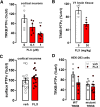Chondroitinase and Antidepressants Promote Plasticity by Releasing TRKB from Dephosphorylating Control of PTPσ in Parvalbumin Neurons
- PMID: 33293360
- PMCID: PMC7880295
- DOI: 10.1523/JNEUROSCI.2228-20.2020
Chondroitinase and Antidepressants Promote Plasticity by Releasing TRKB from Dephosphorylating Control of PTPσ in Parvalbumin Neurons
Abstract
Perineuronal nets (PNNs) are an extracellular matrix structure rich in chondroitin sulfate proteoglycans (CSPGs), which preferentially encase parvalbumin-containing (PV+) interneurons. PNNs restrict cortical network plasticity but the molecular mechanisms involved are unclear. We found that reactivation of ocular dominance plasticity in the adult visual cortex induced by chondroitinase ABC (chABC)-mediated PNN removal requires intact signaling by the neurotrophin receptor TRKB in PV+ neurons. Additionally, we demonstrate that chABC increases TRKB phosphorylation (pTRKB), while PNN component aggrecan attenuates brain-derived neurotrophic factor (BDNF)-induced pTRKB in cortical neurons in culture. We further found that protein tyrosine phosphatase σ (PTPσ, PTPRS), receptor for CSPGs, interacts with TRKB and restricts TRKB phosphorylation. PTPσ deletion increases phosphorylation of TRKB in vitro and in vivo in male and female mice, and juvenile-like plasticity is retained in the visual cortex of adult PTPσ-deficient mice (PTPσ+/-). The antidepressant drug fluoxetine, which is known to promote TRKB phosphorylation and reopen critical period-like plasticity in the adult brain, disrupts the interaction between TRKB and PTPσ by binding to the transmembrane domain of TRKB. We propose that both chABC and fluoxetine reopen critical period-like plasticity in the adult visual cortex by promoting TRKB signaling in PV+ neurons through inhibition of TRKB dephosphorylation by the PTPσ-CSPG complex.SIGNIFICANCE STATEMENT Critical period-like plasticity can be reactivated in the adult visual cortex through disruption of perineuronal nets (PNNs) by chondroitinase treatment, or by chronic antidepressant treatment. We now show that the effects of both chondroitinase and fluoxetine are mediated by the neurotrophin receptor TRKB in parvalbumin-containing (PV+) interneurons. We found that chondroitinase-induced visual cortical plasticity is dependent on TRKB in PV+ neurons. Protein tyrosine phosphatase σ (PTPσ, PTPRS), a receptor for PNNs, interacts with TRKB and inhibits its phosphorylation, and chondroitinase treatment or deletion of PTPσ increases TRKB phosphorylation. Antidepressant fluoxetine disrupts the interaction between TRKB and PTPσ, thereby increasing TRKB phosphorylation. Thus, juvenile-like plasticity induced by both chondroitinase and antidepressant treatment is mediated by TRKB activation in PV+ interneurons.
Keywords: BDNF; CSPG; PTPRS; RPTPσ; chABC; perineuronal nets.
Copyright © 2021 Lesnikova et al.
Figures




References
-
- Antila H, Autio H, Turunen L, Harju K, Tammela P, Wennerberg K, Yli-Kauhaluoma J, Huttunen HJ, Castrén E, Rantamäki T (2014) Utilization of in situ ELISA method for examining Trk receptor phosphorylation in cultured cells. J Neurosci Methods 222:142–146. 10.1016/j.jneumeth.2013.11.001 - DOI - PubMed
-
- Baho E, Chattopadhyaya B, Lavertu-Jolin M, Mazziotti R, Awad PN, Chehrazi P, Groleau M, Jahannault-Talignani C, Vaucher E, Ango F, Pizzorusso T, Baroncelli L, Di Cristo G (2019) p75 neurotrophin receptor activation regulates the timing of the maturation of cortical parvalbumin interneuron connectivity and promotes juvenile-like plasticity in adult visual cortex. J Neurosci 39:4489–4510. 10.1523/JNEUROSCI.2881-18.2019 - DOI - PMC - PubMed
Publication types
MeSH terms
Substances
LinkOut - more resources
Full Text Sources
Medical
Molecular Biology Databases
